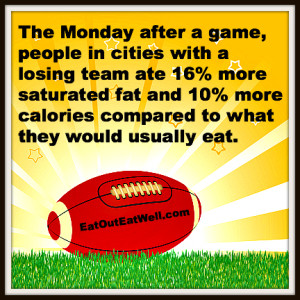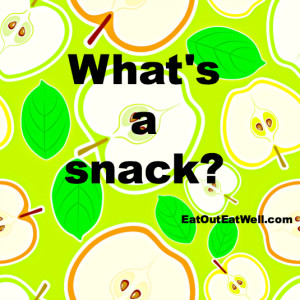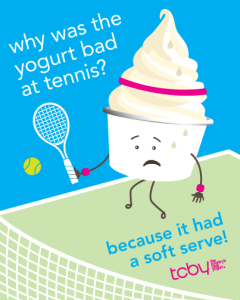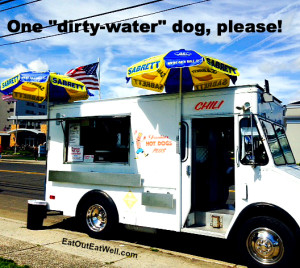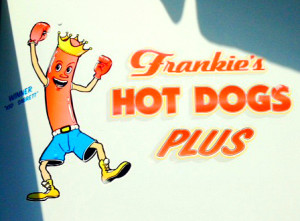 It’s football time. With it comes fun, excitement, joy, angst, wringing of the hands, a whole new spin on vocabulary, and tons of food and drinks.
It’s football time. With it comes fun, excitement, joy, angst, wringing of the hands, a whole new spin on vocabulary, and tons of food and drinks.
It seems that football is associated with nine main food groups: beer, wings, pizza, chips and dip, barbecued ribs, burgers, chili, sausage (especially bratwurst), and pulled pork. It’s a calorie bonanza.
Fans were asked in a national survey if game day calories count. 46% said their diet goes out the window when they’re tailgating or watching their team play and 39% said calories count but they still indulge in a few favorites on game day. No big surprise there.
7 Tips To Keep You Happy . . .
or at least your stomach and waistline happy — your favorite football team is responsible for your mental happiness (or anguish).
1. Be aware of what and how much you’re eating. Mindless munching is a calorie disaster. You’re shoving hundreds of calories into your mouth and it’s probably not even registering that you’re eating. Put a portion on a plate and eat it rather than a constant hand to mouth action off of a platter or open bowl. It’ll save you hundreds of calories.
2. Learn approximately how many calories are in a portion of your favorite game day food so you can make intelligent choices. That way you’re not denying yourself what you love, but if pulled pork has hundreds more calories than a grilled sausage and you love them both, would you choose one over the other?
3. Save your calories for what you love and pass on the other stuff. You don’t have to eat something just because it’s there and it’s traditional football food. If you really don’t love guacamole why would you eat it? Salsa has a lot fewer calories.
4. Don’t be starving at game time (or for the pre-game tailgate). Have a healthy protein based snack (about 150 calories) before the game. Just don’t have a snack and then eat the same amount out of habit – then you’re just adding the snack calories to all of the others.
5. Cut it down a little. Can you have 4 or 5 wings instead of 6 or 7? How about a slider instead of a burger, 2 pieces of pizza instead of 3, or ½ a grinder instead of a whole one? Put only 1 or 2 toppings on your chili instead of sour cream, cheese, guacamole, and a never-ending supply of chips or nachos.
6. If you’re doing some shopping or cooking (or bringing food) for a tailgate or party, try making a slightly healthier version of your favorite food.
- Fried chicken: Use crushed cornflakes for the breading and bake instead of fry
- Nachos: Use low-fat cheese and salsa
- Creamy dips: Use 2% yogurt instead of sour cream
- Chips: Buy baked, not fried
- Chili: Go beans only or use extra-lean ground beef or extra-lean ground turkey instead of ground chuck
- Pizza: order thin crust instead of deep dish and stick with veggie toppings or plain cheese instead of pepperoni or meatball toppings
7. Beer. There’s huge variation between brands and types of beer. On average:
- 12 ounces of beer has 153 calories and 13.9 grams of alcohol
- 12 ounces of lite beer has 103 calories and 11 grams of alcohol
Different types of beer and malt liquor can have very different alcohol content. Light beer can have almost as much alcohol as regular beer – about 85% as much. Put another way, on average:
- Regular beer: 5% alcohol
- Some light beers: 4.2% alcohol
- Malt liquor: 7% alcohol
For an extensive list of the calories in many popular brands of beer, click HERE.
Do you know someone who’s off to college?
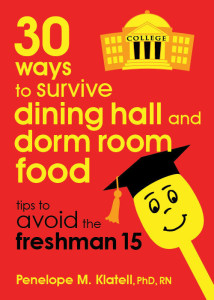 Get my book for some easy, doable tips on how to eat well in dining halls and dorm rooms. Available in print and as an ebook from Amazon and as an ebook from Barnes & Noble.
Get my book for some easy, doable tips on how to eat well in dining halls and dorm rooms. Available in print and as an ebook from Amazon and as an ebook from Barnes & Noble.
